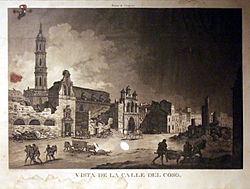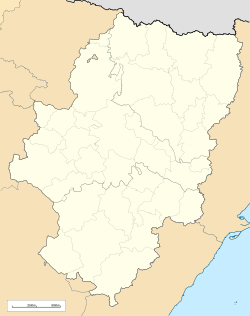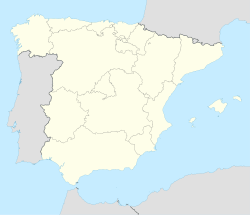Franciscan Friary, Zaragoza facts for kids

Franciscan Friary of Zaragoza
|
|
| Monastery information | |
|---|---|
| Established | 1219 |
| Controlled churches | Franciscan |
| People | |
| Founder(s) | Aragonese royal family |
| Site | |
| Location | Zaragoza, Aragon, now Spain |
| Coordinates | 41°39′8.14″N 0°52′54.01″W / 41.6522611°N 0.8816694°W |
| Visible remains | Demolished |
The Franciscan Friary in Zaragoza, Aragon, Spain, was a big church and monastery built by Franciscan monks. It started way back in 1219. This friary was quite fancy for a Franciscan place, mostly because kings and queens from the Aragon royal family helped pay for it. Many members of the royal family were buried in its beautiful church.
Contents
History of the Friary
The Franciscan Friary was founded in 1219 by Prince Peter of Aragon. The building was badly damaged during the Napoleonic French invasion and the French sieges of Zaragoza in the early 1800s. Its church was very grand, with a single main area that was about 246 feet long and 75 feet wide.
How the Friary Started
The Franciscan order was founded by Saint Francis of Assisi. Eleven years after their order began, his followers arrived in Zaragoza in 1219. They first stayed in a place that later became home to the Augustinian monks. In 1280, they moved to their new building. Prince Peter helped start this new home, and King Pedro IV of Aragon helped finish it in 1357. The king even gave them his orchard. The church itself was finally completed in 1399.
A Center for Franciscans
The history of this Royal Convent is a big part of the history of the Franciscan group in Aragon. It was a very important spiritual center. It helped many other Franciscan convents across Spain. For example, in 1378, three monks from this friary – Friar Raimundo Sanz, Friar Sancho de Fababuj, and Friar Antonio Monrós – went on to found the first "Observant" Franciscan convent in the town of Manzanera.
Damage and Demolition
The Napoleonic French invasion in 1808 severely damaged the friary. An old drawing shows that the church still had a tall, slender Mudéjar tower with three sections. You could also see the main part of the church and its side areas for chapels. The entrance to the friary had three Mudéjar towers on top. The French troops caused even more damage when they used mines to break through during the siege.
Even after all that destruction, a new friary was built from the ruins. It lasted until 1835. A famous arch from the choir area was saved, and the grand inner hall of the convent was used as a church after the war. Sadly, in 1835, a government order led to the friary being closed down. Its parts were then sold off to different people.
The Church and Its Tombs
This magnificent church was the final resting place for several important people.
Royal Burials
- Prince Peter of Aragon: He was the generous founder of the building. Prince Peter was the son of King Peter III "The Great" and the brother of King James II "The Just". He died young in 1296 while fighting in Castile.
- Queen Teresa d'Entença: She was the first wife of King Alfonso IV "The Nice" and the mother of Peter IV "The Ceremonious". Queen Teresa died in 1327 while giving birth to her son Sancho. She was buried near the main altar in a beautiful mausoleum made of marble. Her tomb had her statue dressed as a nun, with crying figures around it. Her young children, Isabel and Sancho, who died as babies, were also buried there. Their tombs were painted on wood. Princess Isabel was shown dressed as a Poor Clare nun, and Prince Sancho wore a garland with his hair loose.
Other Important Burials
Later, the bodies of two other important figures, Bernaldo de Cabrera and Juan de Lanuza, were moved to the church of the Franciscan Friary. They had originally been buried near the Arc of Toledo.
See also
 In Spanish: Convento de San Francisco (Zaragoza) para niños
In Spanish: Convento de San Francisco (Zaragoza) para niños



